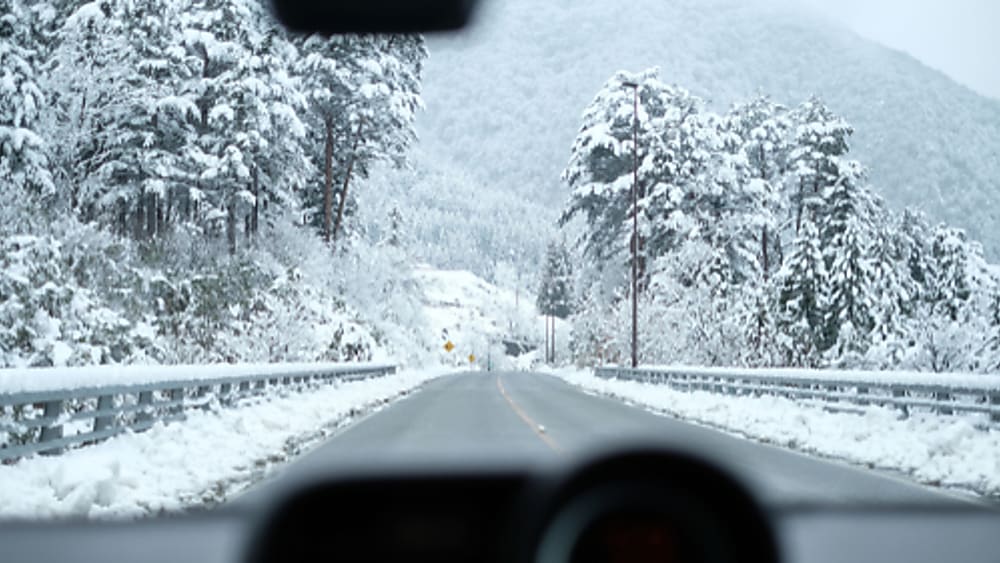Tire maintenance & safety
How to drive on black ice top tips

Best price guarantee
Tire replacement coverage
24/7 roadside assistance
Easy returns
Tire maintenance & safety

Driving over black ice is perhaps one of the most frightening things you can face in the winter. Not because it’s necessarily more threatening than any of the other conditions, but because you likely won’t notice it until it’s too late.
Sliding over black ice is when the reality that driving is a huge responsibility comes back to light. Suddenly, the vehicle is seemingly out of your control and you’re at the mercy of nature, hoping that the cards work in your favor.
As true as that can be, you’re not totally helpless. Driving over black ice can be extremely dangerous, but it is something drivers do every day. We’re here to give you some tips for driving on black ice to not make a mistake that totals your car or worse.
Black ice isn’t actually black. It’s transparent. We only call it black ice because you can see the asphalt beneath it instead of the dull, grey color it will turn when treated for winter weather conditions.
Perhaps the most important thing to know about black ice is that it’s only a thin layer that covers the road's surface. That’s why it doesn’t appear white like thick layers of ice will. It’s important to keep that in mind because black ice might simply appear the same as a wet road will.
That means it can be extremely dangerous. What you might think to be water running across the road is a thin coating of ice. Don’t let that fool you either. Just because it’s thin doesn’t change the fact that it’s ice. Making either mistake can have catastrophic consequences.
So, what do you do when you drive on black ice? The answer can be complicated. That’s because it’s all circumstantial. Black ice can appear in any number of places on the open road, and when and where you encounter it will determine what the exact course of action you should take is.
Keep in mind that what your car does can be rather unpredictable, so there’s no real way of telling exactly what’s going to happen until it starts to happen. So rather than trying to give you a clear step-by-step guide, we’re going to provide you with some essential tips. Combine them with your personal driving skills, and you should be able to determine how you need to react whenever you encounter black ice.
The last thing you need to do is let your nerves get the better of you. We understand that there’s always an ominous tone when discussing black ice, and your natural reaction will likely be to slam on the brakes when you hit a patch, but you can’t let that get to your head. Keep your head on straight, and your chances of maintaining control of your car instantly increase.
Don’t try to blast through black ice. Let your car coast through it. Applying the throttle can cause your tires to spin and send the car spinning out of control. Ease off the pedal and let the car roll over the black ice.
Applying the brakes can be equally as dangerous, especially if you don’t have an anti-lock brake system (ABS). That’s because the wheels can lock up, and that can result in losing control of the car. If you need to apply the brakes, do so in a slow, gradual motion to avoid locking the wheels up.

Do your best to keep the wheels straight until you’re clear of the black ice. That can be easier said than done because counter steering will be very much at play if the car starts to turn one way or another. Correcting that action requires you to turn against the direction the car is sliding, rather than into it.
Sometimes, you can spot black ice before you encounter it, so slowing down and applying the brakes can be vital. Don’t try to bring the vehicle to a total stop if it’s only a small amount of black ice, but make sure you’re at a speed that you are able to manage.
You should always practice driving a safe distance from the driver in front of you, regardless of the season or weather. In the winter, though, you will need to increase the distance. Not just because black ice may be present, but because your tires might not be able to provide enough traction to bring you to a stop in time in case they lose control. You should check your tires monthly to spot uneven wear or other issues, and be sure to give your tires and vehicle a quick inspection before winter hits to help you stay safe.
While black ice can be unpredictable, you can generally tell which areas it’s likely to be present. There’s a good chance black ice will for any time a body of water exists near a roadway or the road sits at any odd angle. That’s because water from streams or melting snow will run across the road and form when the temperature cools down.
It should go without saying that you should always drive with caution along areas of the roads you know to have black ice, even if the temperatures are above freezing.

Black ice can be nerve wracking. Even if drivers encounter it every day and things work out fine, it doesn’t change the fact that black ice is extremely dangerous. Next to panicking, the worst thing you can do is underestimate it.
It’s great if you’re a confident driver, but that doesn’t matter because driving on black ice can be unpredictable. The faster you go, the faster things will spiral out of control, meaning your ability to recover decreases with speed.
Respect the threat. You can get through it without losing your car or being injured as long as you understand the nature of this threat, keep a cool head, and react properly.
You might be shocked by the fact that we didn’t take the opportunity to emphasize the importance of proper tire selection throughout this post. The reason we hadn’t isn’t that tires aren’t important, but because driver reaction is far more important than the equipment you have to work with.
That doesn’t mean you should neglect your tires, even if you’re a veteran of driving over black ice.

The simple fact is that having the right set of tires will help. Their ability to provide traction might be greatly reduced by ice, but that doesn’t change the fact that there are tires better equipped for the situation than others.
Don’t worry. We’re here to help you with the questions relating to winter tire selection. In fact, we have representatives on our customer service lines that will gladly help you pick the perfect set for your situation and they can even help you book an appointment with a preferred installer near you.
Search By